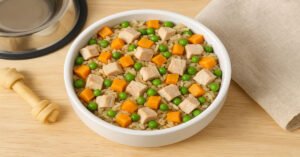Introduction
Homemade Dog Food Recipes: A Healthy and Nutritious Alternative for Your Pet. As a responsible pet owner, you want the best for your furry friend, and that includes their diet. With concerns about commercial pet food ingredients, preservatives, and artificial additives, many pet parents are turning to homemade dog food recipes. Preparing meals at home allows you to control the quality of ingredients, ensuring your dog gets a nutritionally balanced diet tailored to their needs.
This guide provides easy, nutritious, and vet-approved homemade dog food recipes, along with essential tips to maintain a well-rounded diet for your pet. Read on to discover how to prepare healthy homemade meals that will keep your dog happy and energetic!
Benefits of Homemade Dog Food
Switching to homemade dog food has numerous benefits, including:
- Better Nutritional Control – Choose high-quality, fresh ingredients to match your dog’s dietary needs.
- Avoid Harmful Additives – Reduce exposure to preservatives, artificial colors, and fillers found in commercial food.
- Allergy Management – Identify and eliminate allergens that may cause sensitivities or intolerances.
- Improved Digestion – Fresh, natural food can lead to better digestion and reduced bloating.
- Weight Management – Control portion sizes and nutrient intake to maintain a healthy weight.
- Enhanced Coat and Skin Health – Omega-3-rich ingredients like fish and flaxseed support skin health.
Essential Nutrients for Dogs
Before preparing homemade dog food, it’s crucial to understand the key nutrients your pet needs:
- Protein: Essential for muscle growth and maintenance (chicken, beef, fish, eggs, turkey).
- Carbohydrates: Provide energy and fiber (sweet potatoes, brown rice, quinoa, oats).
- Healthy Fats: Support skin, coat, and brain function (salmon oil, coconut oil, flaxseed).
- Vitamins and Minerals: Ensure balanced nutrition (leafy greens, carrots, pumpkin, blueberries).
- Calcium and Phosphorus: Important for bone health (bone meal, eggshell powder, dairy products).
Top 5 Vet-Approved Homemade Dog Food Recipes
1. Chicken and Rice Delight
A classic, simple, and nutritious meal that is gentle on digestion.
Ingredients:
- 2 cups cooked chicken (boneless, skinless)
- 1 cup brown rice
- 1/2 cup carrots (chopped)
- 1/2 cup green beans
- 1 tbsp fish oil
Instructions:
- Boil the chicken and cook the rice separately.
- Steam carrots and green beans until soft.
- Mix all the ingredients and let them cool before serving.
- Store leftovers in an airtight container in the fridge for up to 3 days.
2. Beef and Sweet Potato Power Bowl
This protein-packed recipe provides essential vitamins and minerals.
Ingredients:
- 1 lb ground beef (lean)
- 1 cup sweet potatoes (mashed)
- 1/2 cup peas
- 1/2 cup spinach (chopped)
- 1 tbsp coconut oil
Instructions:
- Cook the beef thoroughly in a pan (drain excess fat).
- Boil and mash sweet potatoes.
- Lightly steam peas and spinach.
- Mix all ingredients and allow them to cool before feeding.
3. Salmon and Quinoa Super Meal
Rich in Omega-3 fatty acids, this meal supports skin and coat health.
Ingredients:
- 1 cup cooked salmon (boneless, skinless)
- 1 cup quinoa (cooked)
- 1/2 cup zucchini (grated)
- 1/2 cup carrots (grated)
- 1 tbsp flaxseed oil
Instructions:
- Cook the quinoa according to package instructions.
- Steam the zucchini and carrots lightly.
- Flake the cooked salmon and mix it with the other ingredients.
- Let it cool before serving.
4. Turkey and Pumpkin Feast
A great recipe for digestive health and overall well-being.
Ingredients:
- 1 lb ground turkey
- 1 cup pumpkin puree
- 1/2 cup green peas
- 1/2 cup carrots (grated)
- 1 tbsp olive oil
Instructions:
- Cook the ground turkey in a pan until fully cooked.
- Steam the peas and carrots lightly.
- Mix everything, ensuring even distribution.
- Let it cool before serving.
5. Egg and Vegetable Breakfast Bowl
A quick and easy meal for a nutritious start to the day.
Ingredients:
- 2 eggs (scrambled)
- 1/2 cup cooked oatmeal
- 1/2 cup spinach (chopped)
- 1/2 banana (mashed)
- 1 tbsp plain yogurt
Instructions:
- Scramble the eggs and cook the oatmeal separately.
- Lightly steam the spinach.
- Mix all the ingredients and let them cool before serving.
Tips for Making Homemade Dog Food Safe and Balanced
- Consult Your Vet: Before switching your dog’s diet, consult a veterinarian to ensure nutritional balance.
- Rotate Proteins: To prevent deficiencies, alternate protein sources like chicken, turkey, beef, fish, and eggs.
- Avoid Toxic Foods: Never include onions, garlic, chocolate, grapes, raisins, avocados, or excessive salt.
- Portion Control: Adjust meal sizes based on your dog’s breed, weight, and activity level.
- Supplement Wisely: Consider adding vet-approved multivitamins if necessary.
- Hydration Matters: Ensure your dog drinks enough water, especially when consuming dry foods.
Comparison: Homemade Dog Food vs. Commercial Dog Food
| Feature | Homemade Dog Food | Commercial Dog Food |
|---|---|---|
| Nutritional Control | Full control over ingredients and nutrients | Limited control; may contain fillers |
| Preservatives & Additives | No artificial additives or preservatives | Often contains artificial additives |
| Food Allergies | Customizable to avoid allergens | May contain common allergens |
| Digestibility | Fresh, natural ingredients aid digestion | Some fillers can be hard to digest |
| Taste & Variety | Offers variety and natural flavors | Limited flavors, often processed |
| Cost | Can be cost-effective with proper planning | It can be expensive for high-quality brands |
| Preparation Time | Requires time and effort | Convenient and ready-to-serve |
| Storage | Needs refrigeration or freezing | Shelf-stable and easy to store |
Foods That Can Cause Food Poisoning in Dogs
🐶 1. Chocolate
-
Contains theobromine and caffeine, which dogs can’t metabolize.
-
Dark chocolate and baking chocolate are the most toxic.
-
Symptoms: Vomiting, diarrhea, hyperactivity, tremors, seizures, abnormal heart rate, and possibly death.
-
Any amount ingested should be reported to a vet immediately.
🍇 2. Grapes and Raisins
-
It can cause sudden kidney failure in dogs.
-
Even small amounts (a few grapes or raisins) are dangerous.
-
Symptoms: Vomiting, lethargy, abdominal pain, decreased appetite, and reduced urination.
-
Immediate veterinary care is necessary.
🧄 3. Onions and Garlic (Allium Family)
-
Damages red blood cells, leading to anemia.
-
All forms are harmful: raw, cooked, powdered, or dried.
-
Garlic is more toxic than onions.
-
Symptoms: Weakness, pale gums, fast heart rate, fainting, and collapse.
🍬 4. Xylitol
-
Found in sugar-free gums, candies, baked goods, some peanut butters, and dental products.
-
Triggers rapid insulin release, causing low blood sugar and potentially liver failure.
-
Symptoms: Vomiting, loss of coordination, weakness, seizures.
-
Effects can appear within 30 minutes and may be fatal.
🍺 5. Alcohol
-
Dogs are extremely sensitive to ethanol (alcohol).
-
Sources include beer, wine, spirits, raw bread dough, and alcohol-based extracts.
-
Symptoms: Vomiting, diarrhea, breathing difficulty, tremors, coma, drop in body temperature and blood pressure.
-
Even tiny amounts can be life-threatening.
🦴 6. Cooked Bones
-
Become brittle and splinter, causing choking or internal injuries.
-
Risks: Broken teeth, stomach or intestinal punctures, blockages.
-
Raw bones are slightly safer but can still carry bacteria.
-
Always consult a vet before offering bones.
🥓 7. Fatty and Greasy Foods
-
High-fat foods (e.g., bacon, sausage, fried scraps) can cause pancreatitis.
-
Breeds like Miniature Schnauzers are especially prone to this condition.
-
Symptoms: Vomiting, diarrhea, stomach pain, loss of appetite.
☕ 8. Caffeine
-
Coffee, tea, sodas, energy drinks, and chocolate usually contain Caffeine.
-
Stimulates the central nervous system and heart.
-
Symptoms: Restlessness, panting, rapid heartbeat, tremors, seizures.
-
Keep caffeinated beverages out of reach at all times.
🌰 9. Macadamia Nuts
-
Causes an unknown toxic reaction in dogs.
-
Symptoms: Vomiting, weakness, tremors, high body temperature.
-
Though rarely fatal, ingestion still needs veterinary attention.
🗑️ 10. Spoiled or Moldy Food
-
Rotten food can contain bacteria and mycotoxins.
-
Common sources: garbage bins, compost piles, and old leftovers.
-
Symptoms: Diarrhea, vomiting, excessive drooling, tremors, seizures.
-
Prevent access to trash and dispose of waste properly.
🥜 11. Raw or Undercooked Meat, Eggs, and Fish
-
May contain harmful bacteria like Salmonella or E. coli, or parasites such as tapeworms.
-
Raw fish like salmon can carry Neorickettsia helminthoeca, which causes Salmon Poisoning Disease (especially in Pacific Northwest regions).
- Symptoms:
- Vomiting
- diarrhea
- fever
- lethargy
- swollen lymph nodes
Feeding raw diets should be done only under veterinary supervision and with proper hygiene and sourcing.
12. Dairy Products
-
Many dogs can’t tolerate lactose because they lack lactase enzyme for its digestion.
-
Consuming milk, cheese, ice cream, or other dairy products can lead to:
-
Gas
-
Diarrhea
-
Stomach cramps
-
Vomiting
-
-
Some cheeses also contain high fat or added seasonings (like garlic), making them even more harmful.
Frequently Asked Questions (FAQs)
1. Can I give my dog a homemade diet every day?
Yes, but ensure the diet is balanced with proteins, fats, carbohydrates, and essential nutrients.
2. How do I store homemade dog food?
Refrigerate for up to 3 days, or freeze in portioned containers for long-term storage.
3. Can I try raw meat for its diet?
Raw feeding is an option, but should be done with veterinary guidance to avoid bacterial risks.
4. Are grains safe for dogs?
Yes, unless your dog has grain allergies. Whole grains like brown rice, quinoa, and oats are beneficial.
5. How can I tell if my dog’s diet is nutritionally sufficient?
Monitor energy levels, coat condition, digestion, and overall health. If in doubt, consult a vet.
6. Can I add dairy products to my dog’s meals?
Some dogs are lactose intolerant. If your dog tolerates dairy, small amounts of plain yogurt or cheese can be beneficial.
7. How often should I change my dog’s diet?
To prevent digestive upsets, change must be gradual.
8. What should I do if my dog refuses homemade food?
Mix it with a small portion of their regular food, and gradually increase the homemade portion.
Conclusion
Preparing homemade dog food is a rewarding way to provide fresh, high-quality meals tailored to your pet’s needs. You can promote their overall health, longevity, and happiness by ensuring a balanced diet with essential nutrients. Try these recipes and watch your dog enjoy nutritious, homemade meals!


